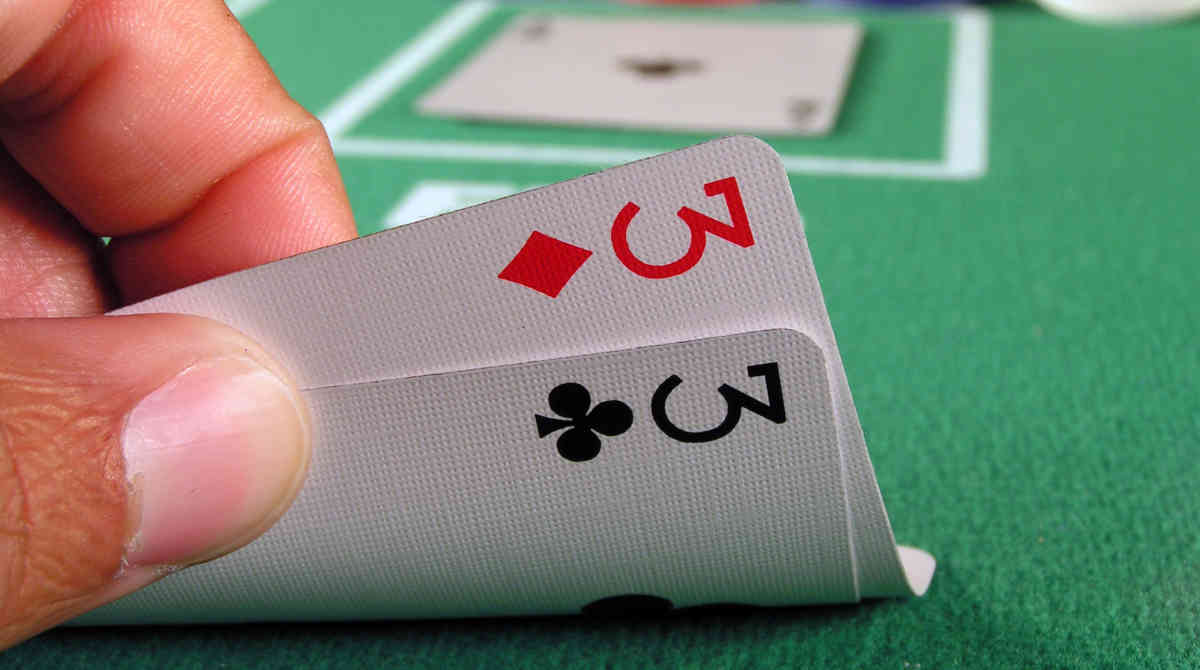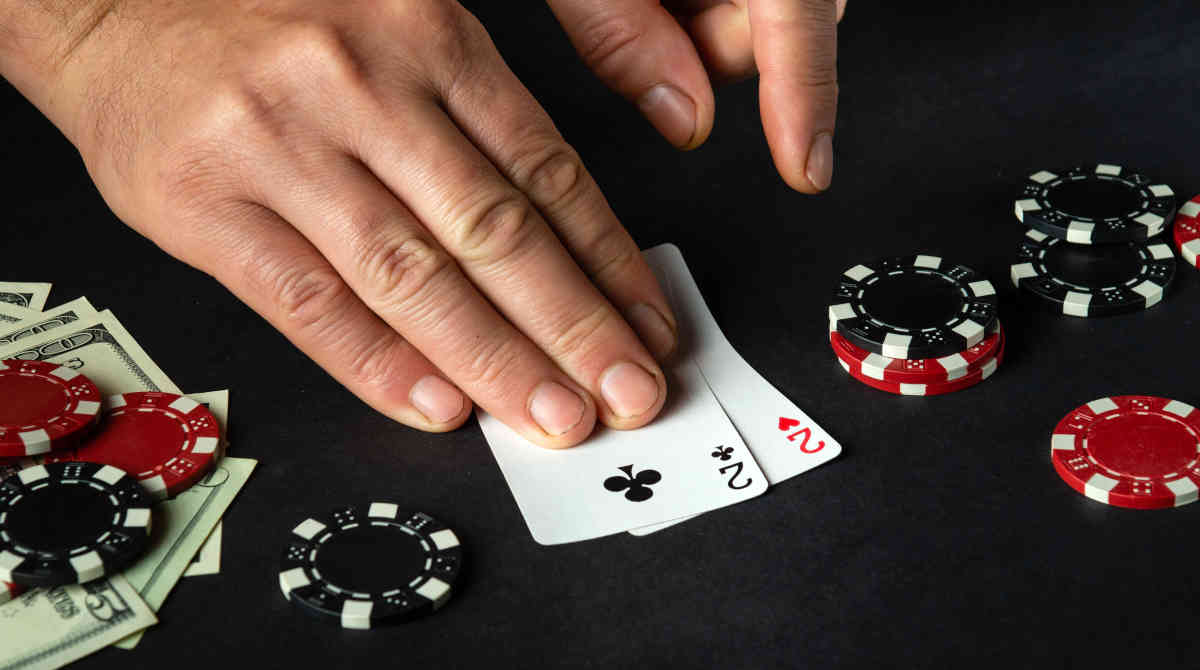How to Play Low Pocket Pairs in Texas Hold’em

10 minutes
In Texas Hold’em poker, pocket pairs hold a significant role in shaping your overall strategy.
Among them, low pocket pairs, deuces through sixes, require special attention and skillful play to maximize their potential.
Whether you are a beginner or a seasoned poker player, mastering the art of low-pocket pair play can significantly improve your overall poker game.
This article explains the ins and outs of playing low pocket pair in Texas Hold’em. From understanding what low pocket pairs are to navigating preflop and post-flop situations, we will provide you with the strategies necessary to make the most out of these hands.
Understanding Low Pocket Pairs in Poker
Before we jump into the low pocket pair strategy, let’s first explain what poker players mean when they say low pocket pairs and how position and odds should impact your decisions with these hands.
What Are Low Pocket Pairs in Poker?
Low pocket pairs in poker refer to the starting hands that consist of two cards of the same rank ranging from 2-2 to 6-6.
Among starting hands, these hand combinations hold distinct value due to their potential to form a set (three-of-a-kind) after the flop.

While they may seem modest in strength compared to higher pocket pairs, low pocket pairs have their strategic significance. They can provide opportunities for deception if played correctly.
However, it is essential to understand that low pocket pairs have limitations and require careful hand evaluation based on position, table dynamics, and odds.
Importance of Position and Table Dynamics
Position and table dynamics play a crucial role when it comes to playing low pocket pairs in poker.
Position refers to your seating arrangement relative to the dealer button, which determines the order in which you act in each betting round.
Playing low pairs from late position, such as the Button and the Cutoff, provides distinct advantages as you have more information about your opponents’ actions.
As a result, it allows you to make more informed decisions and potentially extract additional value from your hand.
Table dynamics should also be considered when playing pocket pairs in poker. Assessing how your opponents are playing can significantly improve your decision-making with this range of hands.
Understanding their tendencies, aggression levels, and willingness to fold or call allows you to adjust your strategy accordingly.
Adapting to the table dynamics helps you maximize the value of your pocket pairs by choosing the most profitable actions, such as extracting value from loose opponents and avoiding confrontation with tight opponents.
Odds and Probabilities Associated With Low Pocket Pairs
Low pocket pairs in poker come with specific odds and probabilities that you need to be aware of.
- The odds of being dealt any specific low pocket pair, such as 3-3 or 4-4, is approximately 0.45%.
- The chances of hitting a set on the flop with a low pocket pair are 11.8%.
- Odds of completing a set increase as the hand progresses to the turn and river.
Considering the odds of facing overcards (higher-ranked cards) on the board is essential, which can diminish the value of low pocket pairs when you don’t hit a set.
Understanding these probabilities will help you make better decisions about whether to invest in the hand or employ a specific strategy like set mining.
Preflop Strategy for Low Pocket Pairs
Developing a solid pre-flop strategy for low-pocket pairs is crucial for success.
Regarding these types of poker hands, you must have a basic preflop strategy that you can adjust based on critical elements such as position, table dynamics, and odds.
Mastering the preflop strategy for pocket pairs will tremendously increase your success on later streets.

Consider the Stack Sizes
To fully capitalize on the value of pocket pairs, you must have a big enough stack.
When playing with 30-50 big blinds, the value of low pocket pairs diminishes since there needs to be more money behind to justify the investment. Hitting a set may not yield enough winning to offset the times you miss (low implied odds).
However, with a stack size of less than 20bbs, low pocket pairs regain their playability, but primarily as shoving (going all in) hands.
By going all-in, you can fold out hands that have a significant equity against you (such as two overcards) and ensure that you realize the full equity of your hand, which is typically around 50%.
Take into Account Your Position
You should constantly adjust your preflop strategy with pocket pairs based on your position at the table.
When seated at a 9-handed table, you are best of with folding pocket pairs in the first two positions (UTG and UTG + 1). This is because these early positions make it difficult to defend against 3-bets from later positions as you will be out of position after the flop.
In addition, the likelihood of facing aggression from players that act behind you is much higher since more opponents are left to act. Also, playing against a single caller out of position post-flop can pose a challenge.
From the UTG+2 position, you can open 5-5 and 6-6, but we recommend folding any pairs lower than that.
Opening weaker pocket pairs at full ring tables from early positions will not have sufficient equity to justify the play.
However, at a 6-max table, it is generally acceptable to open-raise with all pocket pairs from any position. The exception is when the table consists of loose players, as the threat of aggression from players that act behind you may warrant folding the lowest pairs from the UTG position.
If you are an inexperienced player, consider folding the lowest pairs from UTG, regardless of positions to avoid challenging post-flop situations.
Importance of Pot Odds and Implied Odds
When playing low pocket pairs in poker, understanding pot odds and implied odds is essential for making informed decisions.
Pot odds refer to the ratio between the current size of the pot and the cost of a call. They help you determine whether the current payoff justifies the investment.
With small pocket pairs, the decision to continue or fold often depends on the pot odds. If the pot odds are favorable, it may be profitable to proceed.
Implied odds, on the other hand, consider the potential future bets that you can win if you hit a good hand. Since low pocket pairs have the potential to make sets, a disguised combination, the implied odds are a very significant factor.
Because of this, assessing the likelihood of extracting additional chips from your opponent after hitting a set is crucial when deciding to continue with the hand.
You can make more accurate decisions when playing low-pocket pairs by factoring in pot odds and implied odds. It allows you to weigh the potential rewards against the risks and make choices that maximize long-term profitability.
Postflop Strategy for Low Pocket Pairs
Navigating the post-flop rounds with low pocket pairs is the hardest part of the strategy for these hands.
However, once the community cards are revealed, navigating the board texture and making informed decisions becomes paramount.
In this section, we explore key considerations, including continuation betting, position, and adjusting strategies based on your opponents’ actions to maximize the value of pocket pairs.
Analyzing the Board Texture
Analyzing the board texture is essential when playing low pocket pairs in poker.
The board texture refers to the composition of the community cards and how they interact with your hand. Based on this, you can determine how strong your hand is post-flop.
Evaluating the board texture and understanding how it interacts with your and your opponents’ ranges helps you assess the strength of your low pocket pair compared to your opponents’ possible holdings.

In most situations, a coordinated and draw-heavy board diminishes the value of your pocket pair, while a dry and disconnected board increases its strength.
The presence of a potential straight or flush draw creates a higher probability that an opponent might have a strong hand. Also, it increases the likelihood that you will be facing bets from opponents that are semi-bluffing.
Conversely, when the board is dry, fewer potential hands can beat you, and there is a lower chance that your opponents will put a lot of pressure on your pocket, paired with bluffs and semi-bluffs.
Continuation Betting
With low pocket pairs, c-betting can be effective in certain situations. However, the success of your c-bet will also depend on the board’s texture.
Continuation betting involves betting on the flop after being the pre-flop aggressor, regardless of the strength of your hand.
With small pairs, c-betting is most effective when the board favors your hand, such as on dry or uncoordinated boards.
In these situations, there is a higher chance that a c-bet will capitalize on the perceived strength of your pre-flop aggression and potentially win the pot uncontested.
However, when the flop is coordinated or draw-heavy, you should be more cautious with c-betting since there is a higher chance that your opponent may have connected with the board or hold potential drawing hands.
Analyzing the board texture and considering opponents’ ranges is crucial for successful continuation bets with low pocket pairs.
Importance of Position
We mentioned that position plays a crucial role in preflop strategy with pocket pairs; the same goes for post-flop.
Having position on your opponents after the flop will allow you to gather more information about your opponents before making your own decisions.
It will also let you play more aggressively with your low pockets, utilizing position to control the post and extract more value from opponents.
Playing out of position with low pocket pairs can be challenging but manageable with the right approach. A cautious and more passive approach is recommended when playing out of position.
This involves checking or calling rather than betting or raising, allowing you to control the pot size somewhat and only commit too many chips with solid information.
It is important to be prepared to fold a wider range of hands than in position when faced with significant aggression or unfavorable board textures.
Mistakes to Avoid With Pocket Pairs
One of the easiest ways to increase your potential returns with low pocket pairs is to avoid some of the most common mistakes.
Getting Involved in Too Many Pots
One of the most important things to remember when playing small pocket pairs is that they lack significant showdown value unless you hit a set.
Because of this, it is essential to give up a considerable part of your pocket pairs (depending on the situation and your position) to avoid leaking too many chips.
To avoid leaking money, staying away from situations where the odds are not in your favor when playing small pocket pairs is crucial. For instance, cold-calling against short-stacked players will often be unprofitable.

On average, you will hit a set only once in every eight flops, so if your strategy relies on hitting a set to win the pot, your opponent must have a stack large enough to make up for the losses that happen when you miss.
Additionally, even if you hit a set, your opponent may have a bigger set or significant equity with a hand connected to the board.
For these reasons, you should carefully assess the situation before getting involved. If the situation is unfavorable, the best course of action is to fold more frequently and avoid potential losses.
Opening from Early Positions
Another common mistake you should avoid when playing small pocket pairs is opening them from early positions or using them to isolate weaker opponents who limp.
These situations can lead to uncomfortable pre-flop and post-flop situations and unfavorable outcomes.
As the preflop raiser, you may encounter challenging scenarios such as facing a significant 3-bet, where calling becomes unprofitable due to bad odds.
Additionally, when you isolate weaker opponents who limp, they are often recreational players who may use unpredictable betting patterns, hindering your ability to make profitable decisions with these hands.
While exceptions may exist, such as particularly tight tables where opponents frequently fold to isolations, these instances are rare.
Generally, it is advisable to avoid opening small pocket pairs from early positions or using them for isolation.
Chasing Sets vs. Big Bets
There are situations where cold-calling with small pocket pairs can be profitable. However, you should always pay attention to the size of the bet to make the optimal decision.
For instance, if the preflop raiser uses a large sizing, such as 3 or 3.5 bbs, instead of the typical 2.2 or 2.5, you are getting significantly worse odds, making cold calling a bad decision.
The same principle applies when you are facing a substantial 3-bet size or squeeze situation where the raise is 13-15 big blinds.
It is generally best to avoid chasing sets in such scenarios unless the recreational player before you has also called the 3-bet, and you have excellent odds to continue.
Conclusion
This article has explored the strategies and considerations for playing low pocket pairs in Texas Holdem.
We have discussed the definition and range of low pockets, the impact of position and table dynamics, the significance of pot odds and implied odds, and pre-flop and post-flop strategies.
Incorporating these principles can improve your overall strategy for playing pocket pairs, leading to improved results across the board.
- Poker Squeeze Play – Which Hands Make the Most Sense for Squeezing? - August 10, 2023
- How to Play Low Pocket Pairs in Texas Hold’em - July 29, 2023
- How to Make Deep Runs in MTTs More Often - July 22, 2023














